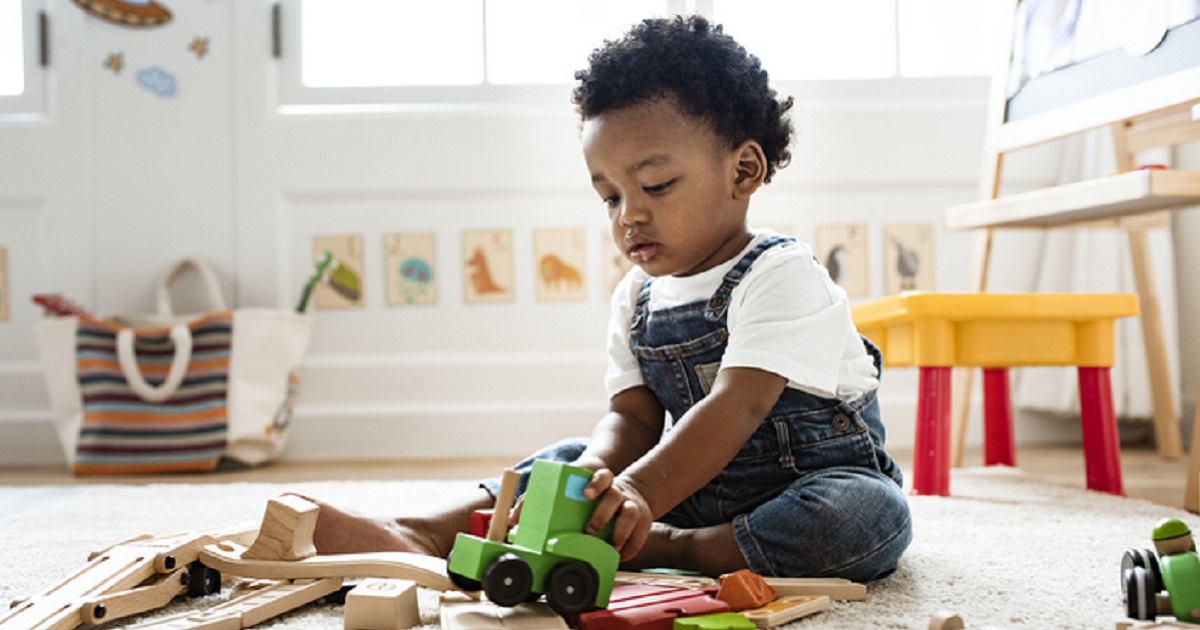Resources for Families with Young Children at Home
Advice to improve your movement, fitness, and overall health from the world's #1 in orthopedics.
From our family to yours, here are some ideas from the HSS Pediatric Rehabilitation team that you and your children can try at home to stay active, engage with each other and foster growth and development.

- Create structure. Help your child feel reassured to understand "what's coming next" by mirroring activities that would have occurred under normal circumstances.
- Have a routine. Make a daily schedule. Choose activities together. Incorporate time for play and movement. During activities, promote learning and development by giving directions or asking specific questions. (See activities below for more ideas.)
- Model behavior. Set an example for what you would like to see in your child.
- Engage in daily routines. Give your child responsibilities, such as setting the table or cleaning up after meals, making their bed or helping with meal preparation or baking.
- Use a multisensory learning approach. Children are multisensory learners—they use their vision, touch and movement systems to learn. Engage with your child in their schoolwork by creating a hands-on science experiment, take a “trip" to the moon, “visit” a historic site or make up a story and act it out.
- Set up for success. Organize your space to help your child navigate their day safely and efficiently.
- Take advantage of technology. Set up a video chat or start a Google doc for virtual pen pal letters with a friend or family member.
Movement and Sensory Activities
Gross motor activities
Gross motor activities help your child stay active, build strength and improve coordination. Try to build in movement breaks throughout the day.
- Take a walk. Outside or in the hallway, try to add some creative moves such as marching, skipping, walking five steps backwards without peeking or taking big steps, little steps and side steps.
- Try an animal walk. Ask your child, “Can you crawl like a crab, walk like a bear, slither like a snake or jump like a frog?” Encourage your child to come up with their own animal walk.
- Do Simon Says or Follow the Leader. Play these classic childhood games together. Take turns leading and see what creative ideas your child can come up with.
- Play Red Light, Green Light, 1, 2, 3. The leader closes their eyes and calls out “red light, green light, 1, 2, 3” while the other player(s) try to get close enough to tag the leader. When the players hear the leader say “3!” everyone stops and freezes. Whoever moves their body has to go back to the beginning. The first person to reach the leader takes their place.
- Start a challenge. Count how many jumping jacks or push-ups your child can do or the amount of time they can balance on one leg. See if they can beat it the next time.
- Use ball games. Play games like hot potato or over-under with a ball. A pillow or other household item can work too.
- Set up an obstacle course. You can make a safe obstacle course with household items, stepping over, crawling under, walking backward or side stepping to navigate across a room.
Calming activities
Calming activities help your child’s system to organize and regulate. This is especially important as everyone’s routines have shifted, there is less structure and things are more uncertain.
- Practice yoga and mindfulness. Search for studios offering online courses, watch “Good Morning Yoga”, “Superpower Listening” or “Dragon Breathing” on the Cosmic Kids Yoga YouTube channel or sign up for a family GoNoodle account.
- Snuggle. Wrap your child up in a cozy blanket on the couch. For something more active, roll them up like a wrap, sushi roll, burrito or their favorite food.
- Build a fort. Make a quiet space to relax, read or take a break.
- Take a bath. Help your child transition to bed time or end the day with a bath in relaxing warm water.
- Listen to music. Choose music with repetitive percussion, soothing sounds or classical rhythms.
Fine motor activities
Fine motor activities promote the development of refined movements for precision and accuracy.
- Do a word search. Create a word search and see if another family member can find the hidden words.
- Create an art Gallery. Have your child create and display their artwork in a home gallery. Have them give you a tour.
- Check out artists. Check out artists sharing their inspiration online, such as Mo Willems Daily Doodle, for ideas they can re-create.
- Write and draw. Make a card or draw a picture and share with friends and family. Encourage writing or typing activities such as keeping a journal, writing a story or making a card for someone special in your child’s life.
- Give back. There are many organizations looking for letters and cards you can contribute to. Have your child write a note to a teacher, favorite restaurant or first responder in your community.
- Create a kindness calendar. Note one kind thing you or your child does each day.
- Try beading. Make a friendship bracelet or do a beading project. You can even use household items such as macaroni.
- Play card games. Work on strength, dexterity and other functional hand skills while promoting development in cognitive areas like organization, math and planning ahead. Teach your child a fun card game. Practice sorting, separate by suit, divide into red and black piles or put the cards in number order from smallest to largest.
Alternative positioning
Alternative positioning helps to promote attention and focus, build strength and help a child better regulate by giving different options to move between.
- Positions for work and play. Set your child up to do a puzzle, color or draw while lying on their tummy. Create an art project by securing paper to a wall at eye level so your child can stand and draw at a vertical surface, like an artist at an easel. You can also lie on your backs to read a book together.
- Positions for meal time. Have a picnic for lunch one day instead of sitting at the table for every meal. Everyone can sit on the floor or pillows and have some snacks.
- Add movement. Put puzzle pieces at one end of the room and the puzzle board at the other. Have your child walk, crawl, jump or roll to gather and return each piece to the correct spot in the board. While playing a board game, encourage movement by using the board game pieces or cards. Every time your child picks a card, pair it with a movement challenge, such as jumping jacks, wall push-ups or jogging in place.
Language activities
Modeling, expanding, commenting and asking questions
Modeling, expanding, commenting and asking questions are techniques that can be used during many different activities throughout the day at home.
- Model appropriate language production for your child. Use words for describing (colors, size), showing direction (up, down) or requesting. For example, “give me + item” or “I want + item."
- Expand on or repeat your child's words to increase engagement and language, maintain attention and instill confidence. For example, if your child says “big horse," you can say “big, brown horse.”
- Comment on what your child is doing, feeling or saying to build joint attention and vocabulary. With bubbles, you can comment, “Blow bubbles!” or “Those are big bubbles!”
- Ask questions to provide your child with the opportunity to use their language and practice making appropriate responses. Ask “Who, what, when, where, why and how?”
- Activities to do with your child while incorporating these techniques are:
- Sing. La, la, la! Sing songs with repetition that allow your child to anticipate the next words or sounds in the song, like "Old McDonald" or "Row, Row, Row, Your Boat."
- Read. Take out interactive books with pictures, colors and visuals. Label pictures, ask questions and use silly voices to keep your child engaged.
- Cook/bake. Yum! Label all the ingredients you are using and comment on all the steps using sequencing words (e.g., first, next, last).
- Take a bath. Rub-a-dub! Talk to your child about what you are doing (e.g., I am washing your hair). Label bath toys, describe them and pretend play with them.
- Eat. What’s for dinner? Talk to your child about what you are eating. Describe the size, color, texture (e.g., bumpy, smooth) and taste (e.g., sweet, sour, salty).
- Play with water. Splish, splash! Fill a bucket with water and some toys. Name the different items, talk about their use and engage in pretend play with them.
Following directions
Following directions helps build your child’s overall understanding of language.
- Mr. Potato Head. Say "put eyes on" then “put eyes on, then put shoes on.”
- Simon Says or Follow the Leader. Give your child one, two or three things to follow.
- Freeze Dance. Play a song, dance and freeze once the song stops.
Identification
Identification helps your child understand vocabulary and concepts.
- Puzzles. Scatter puzzle pieces and describe the specific piece you want your child to find. Once found, have your child jump, hop or crawl back to put the puzzle piece in its appropriate spot.
- Bingo. Create a bingo board with animals, toys or food. Describe the item you want your child to find, put a token down and yell “BINGO” when a row is filled up.
- What could it be? Take a shoebox and fill it with different items. Have your child place their hand inside, pick an item and try to figure out what the item is through touch only.
Play and Socialization activities
- Pretend Play. Re-enact familiar routines and build imagination. Let your child take the lead and be as close to eye level with them as possible.
- Grocery Store. Take turns being the cashier and customer using real or toy food. Create a realistic scenario using language and props used at the supermarket.
- Car wash. Scrub the dirt away. Fill a container with soap and water and send through toy vehicles.
- Puppets. Create puppets out of construction paper and popsicle sticks and put on a puppet show.
- Dress up. Have your child put on their favorite costume.
- Charades. Act it out! Pick a category (e.g, animals) and take turns role-playing. See if you can figure out who or what your child is trying to be.
- I spy. Take two toilet paper rolls, glue them together and turn them into binoculars. Go around the house with the binoculars and see what you find!
- Social story. Say cheese! Take photos on your phone and print them out. Have your child put the pictures into a book to tell a story.
Stay Active
- Plan movement breaks into your schedule and encourage frequent position changes.
- Consider nutrition and healthy eating. Snacks can also help your child’s sensory system.
- Crunchy and chewy foods are alerting and organizing, respectively. Drinking through a straw is calming and can help promote focus.
- Many websites are offering discounts or extended free trials for exercise classes you can do with your children, including strengthening, yoga, mindfulness and meditation.
Resources
There are so many resources available and they are growing by the day. Search online and through social media for craft and learning activities, therapist posts, books and recipes. Here are some additional sites our therapists have found:
- Education. Please refer to your child’s academic provider for resources to fit their curriculum. There are many programs available with additional support such as Scholastic Learn at Home. Log on for virtual tours of zoos, museums and historic sites.
- Reading. The New York Public Library and platforms including Audible have expanded access to digital content.
- Other resources. Read blogs such as Encourage Play, Coping Skills for Kids and The Inspired Treehouse. Find digital resources, including printables, craft and learning activities online like New York Family Magazine or social media such as P.S. I Made This.
Talk to children about the novel coronavirus with information from reliable sources, like the US Centers for Disease Control and Prevention.
Be well, stay healthy and wash your hands!
Check on your family, friends and neighbors while maintaining social distancing. We will do our best together to get through this stronger.


